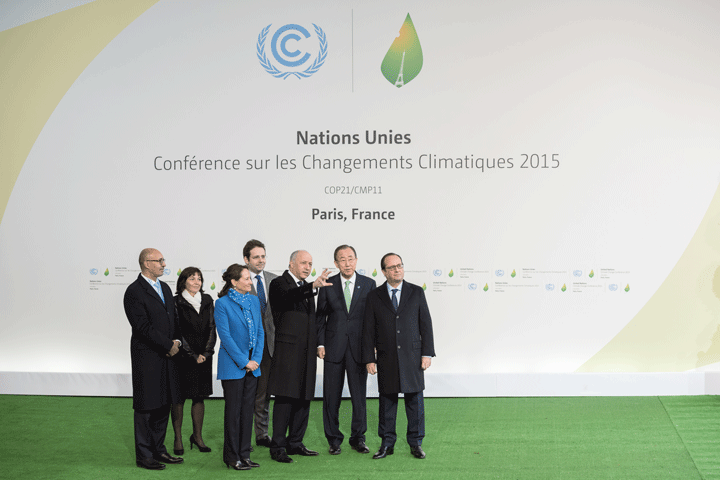More than a month has passed since the end of the twenty-first Conference of Parties (COP21) of the United Nations Framework Convention on Climate Change (UNFCCC).
Renato Roldao, Lead Managing Consultant – Climate Change at ICF International and Vice Chair of the European Chamber’s Carbon Market Working Group, attended this significant event as an official observer. Now that the dust has settled, Roldao says that it is important to move on and build on the political and historical momentum that was generated in Paris. This means global action.

From L-R: Harlem Desir, French Secretary of State for European Affairs; Anne Hidalgo, Mayor of Paris; Segolene Royal, French Foreign Minister for Ecology, Sustainable Development and Energy; Matthias Fekl, French Secretary of State for Foreign Trade; Lauren Fabius, French Foreign Minister of Foreign Affairs and International Development and COP president; Ban Ki-moon, Secretary General of the UN; and French President Francois Hollande
The twenty-first Conference of Parties (COP) was almost unanimously considered a great success. It sent a strong signal to the world that not only is multilateralism as an approach to combatting climate change achievable but that the process has been revitalised, too.
This was not my first COP, but it was a very special one for what it represents in terms of giving the necessary medium- and long-term signals that were needed to trigger global convergence within this century towards a more sustainable and low carbon pathway.
The European Chamber was represented for the first time at a COP after obtaining observer status under the UNFCCC. In total, the Chamber sent a delegation of four member companies’ representatives and I had the pleasure to formally lead in my capacity as the Vice Chair of the Carbon Market Working Group. As well as being a first for the Chamber, it was a first for me to act as an observer having previously participated in the COP13 in Bali as a negotiating party.
I was able to enjoy a totally different perspective of what was going on at Le Bourget (the conference centre) compared to those who were fully immersed in the negotiations, discussing specific, highly detailed and technical issues. This time I was able to feel the positive vibe in the corridors and see how the overall content and process was smoothly shaping up into a successful outcome under the wise leadership of COP president and French Minister of Foreign Affairs, Laurent Fabius.
So in terms of the content, what exactly are the main elements of the Paris Agreement and, more importantly, what they mean?
Since I was at COP21 representing business and the private sector I should first highlight that the Paris Agreement gives a boost to climate actions from companies that will be able to use science-based targets to reduce their emissions. Cities, sub-national government entities and individuals / civil society in general will also have more space to be part of the solution after Paris.
The final text tried to strike a better balance between developed and developing countries, and between the climate adaptation elements—which are a central pillar to help the world’s most vulnerable regions—and mitigation ones. It manages to do this better than any of the previous documents approved under the convention. It sets a compromise of gradually strengthening climate actions that will lead to further emissions reductions through global stocktaking and five-year review cycles. The national pledges or Nationally Determined Contributions (NDCs) enable a truly global and inclusive, bottom-up effort to achieve the convention’s objectives.
There are other elements of the agreement that are also certainly worth mentioning:
- Ambition: the increase in global temperature is to be kept between 1.5°C and 2°C with global emissions to peak as soon as possible.
- Financing: a minimum floor for annual carbon financing post-2020 was set at USD 100 billion to poorer countries, although the role of public and private financing to make it happen still requires further discussions. Developing countries can provide climate financing voluntarily and this seems to be the approach that China had been following so far, to commit funds to south-south cooperation outside the Green Climate Fund (GCF). Countries will need to access climate financing for capacity building.
- Monitoring and Review: all countries should account for their emissions based on principles of environmental integrity, accuracy, completeness, comparability and consistency. There are commitments to enhanced transparency through the establishment of a robust framework under the convention that need to be further elaborated in forthcoming meetings in order to make sure that the commitments are met. There is also a long-term goal to achieve a balance of emissions and sinks (meaning carbon ‘neutrality’) by the second half of the century;
- Carbon markets and market-based approaches: there is a placeholder for future use of market-based approaches with a reference to cooperative approaches and international transferred mitigation outcomes (ITMOs). Transparent rules and details that do not risk environmental integrity are to be defined in future meetings. There is also a framework for non-market approaches.
The Paris Agreement was a breakthrough in international climate policy, but is not an end in itself and will not solve the problem of global climate change in the absence of concrete and implementable actions that should follow. It is, though, a fresh start that offers a route to the solution.


Recent Comments